Separating Fact and Fiction About the Special Flushing Waterfront District
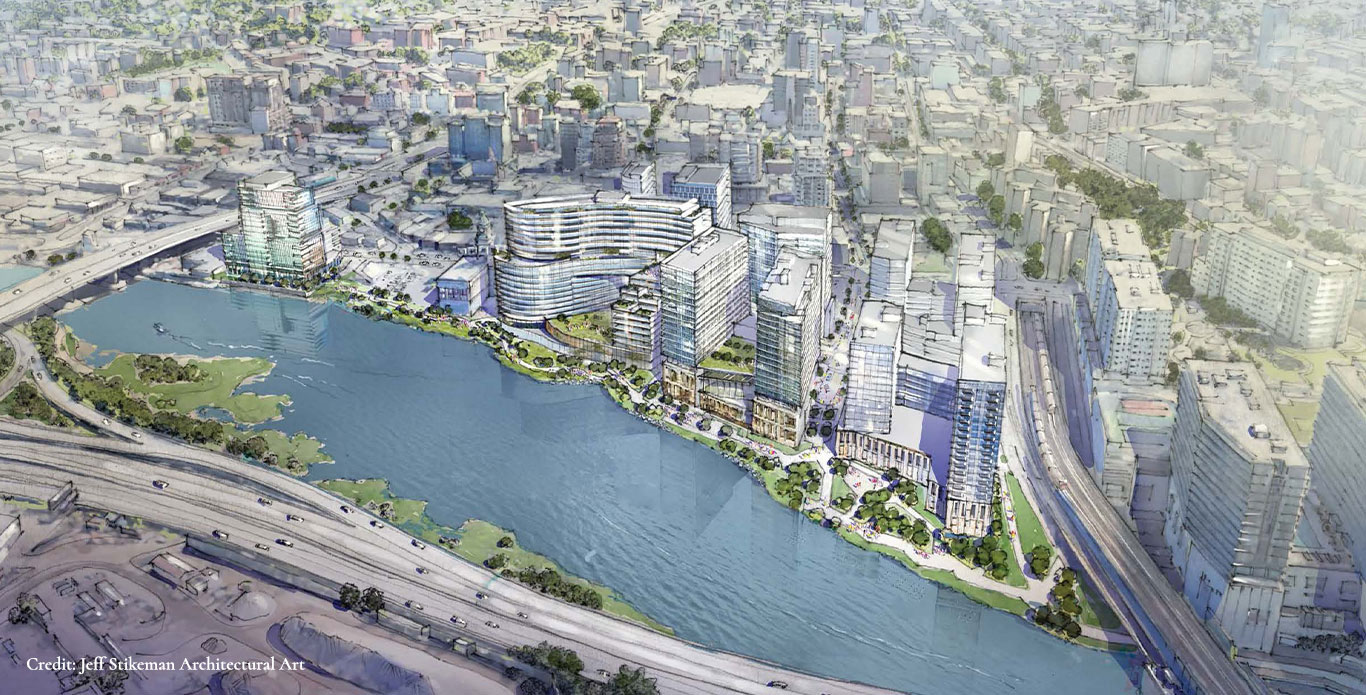
Rendering of the Special Flushing Waterfront District
There are several myths and mischaracterizations about the Special Flushing Waterfront District (SFWD) that we as owners want to set the record straight about. Here are several key facts about the project.
SFWD does not provide an advantage to obtain building height.
The Federal Aviation Administration (FAA) and Port Authority of New York and New Jersey have already provided Letters of No Objection to allow height increases for the Special Flushing Waterfront District. SFWD only provides a consolidation of approval processes. Rather than submitting to the Board of Standards and Appeals for this, special permit approval would be provided by the City Planning Commission as part of the SFWD Waterfront Certification process. FAA and Port Authority Letters of No Objection have to be provided for this administrative approval.
In the past 20 years, the dozen special permits for height granted in Downtown Flushing were all routinely provided upon submission of FAA and Port Authority Letters of No Objection.
There will be zero sanitary sewer discharge into Flushing Creek.
All sanitary sewer effluent will be piped directly to Tallman Island Treatment Plant in College Point. Some say other developments pollute Flushing, making it seem like SFWD will do the same, but that is provably false.
SFWD provides comprehensive stormwater runoff mitigations to prevent shoreline erosion and provide prudent shoreline restoration techniques, such as: permeable pavers, green roofs, soft shoreline edges, and onsite stormwater retention before discharge into Flushing Creek.
As-of-Right vs SFWD: The exact same buildable bulk.
The as-of-right development scenario can currently be built. SFWD is not needed to achieve maximum bulk. At least two of the sites have plans that demonstrate this, one already with New York City Department of Buildings-approved building plans, ready to proceed. Opposition makes it appear this is not the case and that residential units, commercial and retail space are all being incrementally added.
Macedonia AME Church is not a victim.
The Macedonia AME Church was beneficially rezoned as part of the Municipal Lot #1 ULURP in 2010. That was an economic boost for them and they are an important stalwart in our community. Macedonia built 142 affordable housing units at their Macedonia Plaza site. We know Reverend Richard McEacheron and he voted for the Special Flushing Waterfront District as a member of Queens Community Board 7 and he testified in support of SFWD at the City Planning Commission and City Council hearings. There are no complaints from him or his congregation.
Community Support
At the recent City Council hearing, over 75% of the 100+ speakers were in favor of our project and its many merits. The Council also received more than 330 letters of support for the Special District from Flushing residents and business owners. The community clearly supports this project.
Queens Community Board 7 represents Flushing, among other neighborhoods. Minkwon Center may be vocal, but that does not make it the town crier for Flushing. Minkwon representatives have never appeared at any Queens CB7 hearings prior to the Special Flushing Waterfront District or since. It has its own agenda and refuses to meet with representatives of SFWD.
SFWD is not designed to provide a solution for homelessness nor ensure union jobs. It is designed to provide a better urban experience and numerous community benefits, including:
-A new road network, vital to our community, to alleviate College Point Boulevard traffic and connect the Special Flushing Waterfront District to Downtown Flushing.
-A fully public waterfront promenade doubled in width to 40 feet and extended by more than 400 feet in length.
-Space for seniors, youth groups and community organizations.
-6.6 acres of public open space, whereas as-of-right development would bring only 3 acres.
-Design that will allow for small local storefronts and better pedestrian experiences on the street and waterfront.
-An ideal public-private partnership between the Department of City Planning and three developers, designed to prevent the construction of three "Skyview" developments.
The current proposal seeks enhanced zoning for only 10% of the overall project on a small lot to the north, also entirely on private land. The vast majority of the project has no change in zoning at all, including the area encompassing the new public road network that will alleviate traffic and grant direct access to the waterfront. There is no increase in bulk, except a small portion in the north to allow a 400-foot extension of the waterfront promenade and to provide some affordable housing units.
If you want to advance more affordable housing, then you should contact the Mayor, the President of the New York City Economic Development Corporation (EDC), and City Council Member Francisco Moya. Insist on more affordable housing at Willets Point, which is public land.
A defeat of the SFWD does not advance the affordable housing issue. Defeat will remove affordable housing from the sites completely, and all the benefits described above.
***
by Richard Siu of F&T Group; William Xu of United Construction & Development Group; and John Liang, Young Nian Group.
***
Have an op-ed idea or submission for Gotham Gazette? Email This email address is being protected from spambots. You need JavaScript enabled to view it.
For Students’ Sake, New York City Should Keep Schools Open
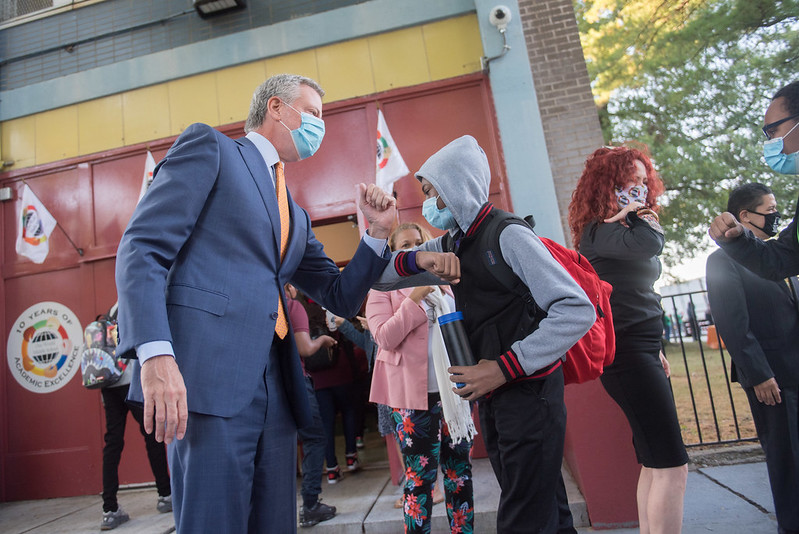
(photo: Michael Appleton/Mayoral Photography Office)
As the city’s seven-day rolling average positive test rate for COVID-19 approaches 3% and with the Mayor and Department of Education seemingly on the brink of closing schools again, public school parents, like me, are anxious and angry. Students, teachers, administrators, and parents have done everything we promised to keep our schools open, safe, and healthy. Shutting down schools that have experienced few or no covid cases makes no sense. Shutting down all in-person schooling is an assault on parents and students.
When the 3% threshold was agreed to by Mayor de Blasio and the teachers union there was great uncertainty about the safety of opening schools. Setting a conservative threshold to respond to reasonable concerns of teachers made sense. However, through small classes, social distancing, mask compliance, and a robust testing and tracing protocol, we proved that schools can open safely under the right circumstances. Even as the citywide positivity rate has increased, the positive test rate in schools has remained far less than 1%.
In my family, I was, and still am, the parent responsible for remote learning. I am the one who essentially left the workforce to give our kids stability at home. I know first-hand that, despite Herculean efforts by our teachers and administrators, remote learning is hurting our children’s academic progress and harming their mental health. It is widening the achievement gap between wealthier, predominantly white, students and poorer students, who are predominantly students of color.
Yet, despite all the challenges of remote learning, many parents decided to start the year fully remote. After so many months of chaos, parents just want to provide continuity for our children. Many parents felt that the best way to do this was to start the year all-remote because the possibility that kids could return to school, only to have them shut down as in the spring, would be devastating and harmful for their children. For many, the plan was to opt back in to some in-person learning after winter break if the opening went smoothly, which it did.
Despite this success, the city is going to throw it all away by adhering to an artificial threshold that flies in the face of science and data. Parents are now again stuck with the fear that they could opt their children into blended learning with some in-person school days, only to have school buildings close shortly thereafter, creating even more disruption and chaos in their lives.
Likewise, students already in the hybrid model are doing well. They are happy to be back in school, with their friends and teachers, returning to some semblance of normalcy. Taking that away from them is unconscionable.
It is time for the city to make decisions by weighing the very substantial harm that remote learning is doing to our children with the risk of keeping schools open. The harm has proven high and the risk has proven low. Schools can and should remain open unless and until there is significant linked transmission within schools. The entire school system should not shudder all buildings to in-person learning unless community spread of covid is so significant that it has overwhelmed the ability to provide the robust testing and tracing required to keep our schools safe.
Our children are suffering and hurting from the lack of in-person instruction and parents are hurting from the mayor and Department of Education’s ad hoc decision making. If we are going to meet our obligation to provide a quality public education for every New York City child, it is far past time to prioritize the health, well-being, and education of our children over all other considerations.
***
Doug Schneider is a parent who lives in Brooklyn and a candidate for New York City Council in District 39. On Twitter @DougSchneiderBK.
***
Have an op-ed idea or submission for Gotham Gazette? Email This email address is being protected from spambots. You need JavaScript enabled to view it.
Before New York City Schools Close Again, This is What Students with Disabilities Need
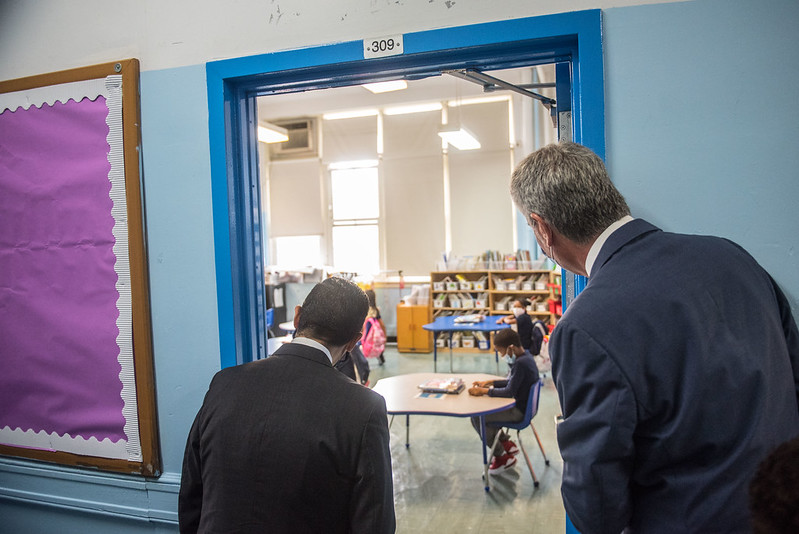
The mayor and chancellor at a school (photo: Michael Appleton/Mayor's Office)
Over 300,000 New York City students with disabilities still do not have the means to learn and receive services effectively online. And families can no longer emotionally endure being full-time caregivers, teachers, and therapists. The city needs a plan right now.
The pandemic has further widened the achievement gap between students with disabilities and their peers. Remote learning and teletherapy -- speech, occupational, and physical therapy, as well as counseling over a screen -- does not work for most students. Students need to be able to engage independently or need to have an adult available to support them.
Students with disabilities need consistent access to devices, broadband, and space for their learning environment. They need live and in-person instruction with licensed special education teachers. For effective teletherapy services, providers need more training on how to deliver quality services online. In their annual special education report (via Local Law 27) issued earlier this month, the New York City Department of Education conceded that it does not know how many students received any or all of their mandated services from March through June of this year when all school buildings were closed.
The city also needs to communicate clearly and directly with families on covid exposures, as well as school-based and system closures. Communications must be expedient, accessible, and multilingual. School closure has already been especially traumatic for students with disabilities and that continues to be further compounded by lack of timely information from the city and individual schools.
The constant disruption to students’ routines, schedules, and access to their school communities often triggers behaviors that prevent learning from occurring. The city must provide immediate guidance to schools and educators on how they can address the social-emotional needs of students with disabilities, including students with significant developmental and intellectual disabilities.
All students need high-quality learning and social opportunities, but in the current environment, students with disabilities are especially isolated. A persistent lack of in-person interactions and community will have an irreversible, long-term impact on their academic progress, behavior, and future independence, education, and employment.
This year, remote and blended learning have created many educational gaps and provoked much analysis. The city needs to have a plan to provide in-person instruction and services for students with disabilities right now before it closes all school doors again.
***
Barbara A. Glassman is the Executive Director of INCLUDEnyc, a non-profit helping young people with disabilities, their families, and the professionals who support them; including a Help Line for assistance in English, Spanish, and over 200 languages. On Twitter @GlassmanBA and @IncludeNYC.
***
Have an op-ed idea or submission for Gotham Gazette? Email This email address is being protected from spambots. You need JavaScript enabled to view it.
For an Equitable Recovery, New York Must Utilize Our Manufacturing and Industrial Sector
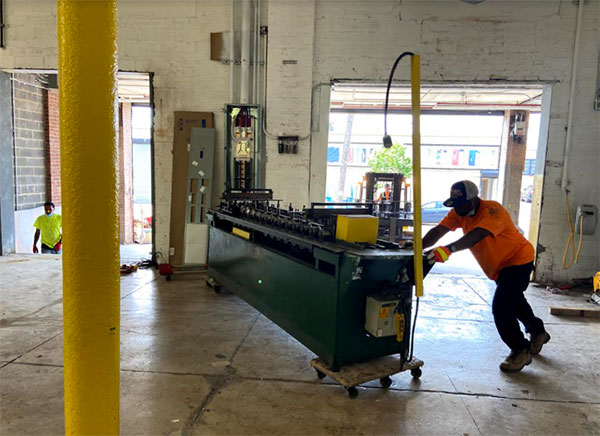
DNJ Mechanical Corp. moving into Maspeth (photo: BOC Network/Maspeth Industrial Business Association)
As we get deeper into the current crisis, it’s becoming clearer that New York won’t simply bounce back to “normal.” We need effective strategies to transform our city’s infrastructure and economy. Policies aimed at protecting and growing industrial jobs can improve not only our citywide economy, but the nearby low-income residential communities and the lives of the predominantly of-color manufacturing workforce.
As industrial business service providers, we ask our current and future decision-makers to look more closely at the role industrial land, businesses, and jobs can play in ensuring an equitable recovery in New York City.
New York City has 21 officially designated Industrial Business Zones (IBZs) whose land is zoned for industrial uses, including traditional manufacturing of goods like furniture, clothing, and machines, as well as food production, wholesale, and sanitation facilities, warehousing, and research labs. Not all of the city’s manufacturing land exists within these areas, but the protection offered by the IBZ designation helps to mitigate the impact of speculation and prevent industrial businesses from being pushed out of the city in favor of other, more lucrative uses.
So why does it matter if we keep industrial businesses in New York City?
We are at the intersection of three crises: the COVID-19 pandemic; an economic collapse triggered by the pandemic and worsened by decades of disinvestment and inequality; and systematic racial injustice highlighted by this year’s massive protests and the pandemic’s disproportionate impact on low-income communities and communities of color. The manufacturing and industrial sector provides a key to addressing all three crises. New York’s industrial businesses make and distribute PPE and other medical equipment, boost our local economy, and provide good jobs for workers of color and minority-owned businesses.
In 2019 in New York City, manufacturing jobs paid an average annual wage of $69,161. Meanwhile, food service jobs paid $30,685 per year, and retail jobs paid $38,450. Mayor de Blasio and the City Council has devoted lots of creative energy to ensuring that restaurants can continue operating; we want to see that same energy aimed at ensuring the success of industrial businesses that pay twice as much to a workforce that is 80% people of color and 50% foreign-born. These are the jobs for the people who have been most impacted by COVID-19, situated in the neighborhoods most impacted by COVID-19.
Many aspects of city policy affect the industrial sector’s ability to thrive: land use and planning, transportation, economic development, workforce development, small business services, environment and sustainability, and others. We need to see our city’s leaders taking a smart and integrated approach to these areas that recognizes the critical role of manufacturing.
The Department of City Planning’s recently released draft framework for a Comprehensive Waterfront Plan, which puts forward the goals of resiliency, equity, and health, is one example of a process where this approach is important. We want to see a strong emphasis on the waterfront’s role in providing equitable economic activity, not only for port use but also as a home and supportive ecosystem for the industrial employers and workers that sustain the health of our communities.
Here are three ways the city can support manufacturing jobs:
Adopt a new approach to land use that preserves the industrial business zones and additional manufacturing land. This approach, which the Department of City Planning explored in the North Brooklyn Industry & Innovation Plan, would prioritize more intensive, job-generating industrial uses that support the city’s resiliency, and restrict non-compatible uses like stand-alone office space and recreational facilities.
Increase alignment and collaboration between and among city agencies whose work impacts the manufacturing sector. This includes agencies that may not be assumed to focus on economic development, but whose purview affects business growth, such as the Department of Transportation, Department of Sanitation, and Department of Buildings.
Make better use of the resources that the IBZs already have, including the support networks built and sustained by the Industrial Business Service Providers. Many of these organizations have historical roots in New York City’s industrial neighborhoods, and they have the ability to leverage their deep knowledge of the communities’ needs to inform city policy and to disseminate information about programming to businesses in their respective communities.
As New York City continues to confront these deep-seated crises, we hope that decision-makers will recognize and embrace the manufacturing sector’s role as part of the way forward to a more equitable future.
***
By Leah Archibald, Executive Director, Evergreen Exchange; Nancy Carin, Executive Director, Business Outreach Center Network; Quincy Ely-Cate, Director of Industrial Business Development, Maspeth Industrial Business Association; Niles French, Vice President of Projects, Staten Island Economic Development Corporation; Ben Margolis, Executive Director, Southwest Brooklyn Industrial Development Corporation. The authors are all members of the Industrial Jobs Coalition, a citywide alliance of community groups, policy advocates, and service providers fighting to protect and preserve manufacturing as a sector in New York.
***
Have an op-ed idea or submission for Gotham Gazette? Email This email address is being protected from spambots. You need JavaScript enabled to view it.
A Flushing Tragedy Underscores Acute Affordable Housing Crisis
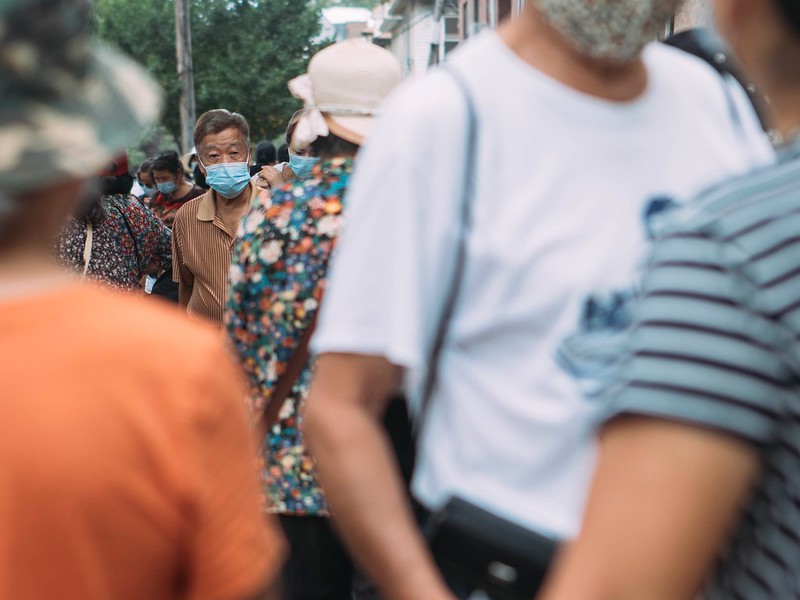
A line for food in Flushing (photo: Emil Cohen/City Council)
Pedro Rodriguez posted a video to Facebook of a homeless man bent over and lifeless in his cardboard shelter made up of several boxes, with one serving as the shelter’s threshold where the elderly Asian man had neatly placed his shoes. Posted this past Saturday morning, Rodriguez’s video ended with Fire Department responders lifting the man’s torso and ascertaining he had died hours earlier. Rodriguez, who works at La Jornada, Flushing’s largest food pantry, noted a growing presence of homeless people on downtown Flushing’s Prince Street due to the coronavirus pandemic-induced economic and housing crises.
Just days earlier, the chair of the New York City Planning Commission, Marisa Lago, prefaced her vote to approve the highly controversial Special Flushing Waterfront District (SFWD) by congratulating the Queens Department of City Planning team and local property owners and developers for two decades of collaboration on a waterfront redevelopment proposal that will advance Flushing’s future and help the city recover.
On Monday, the New York City Council’s zoning subcommittee held a public hearing on the developers’ SFWD proposal to waive rules regulating building heights and waterfront access to permit the development of a 29-acre, mixed-use luxury residential and commercial enclave complete with a private street network.
The Special Flushing Waterfront District applicant, FRWA LLC, is comprised of three Chinese transnational developers – F & T Group, Young Nian LLC, and United Construction – and they argue their proposed 3 million square feet of new development will not lead to residential displacement because the waterfront is largely vacant. This view, however, fails to recognize the developers’ contributions to a speculative real estate market that threatens all forms of affordable housing in downtown Flushing.
A striking example is a modest, two-family residential property on Sanford Avenue that was pitched as a “prime investment opportunity” for condominium development and sold in May 2019 for $3.4 million.
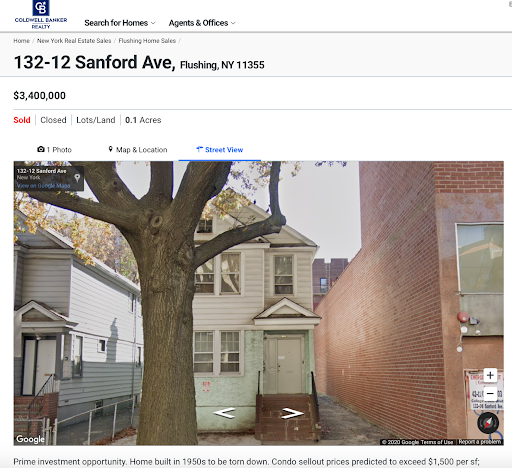
Private developers are loath to concede their projects facilitate (direct or indirect) displacement but it is especially egregious when city government planners and elected officials approve a massive, market-driven real estate development in Flushing (much less without a full environmental impact study and review) that will further jeopardize the neighborhood’s diminishing affordable housing stock, putting thousands of working-class residents at risk of homelessness.
There could be no more stark relief of the human toll of Flushing’s already acute affordable housing crisis than Rodriguez’s heartbreaking video. The Department of City Planning’s study of (pre-pandemic) downtown Flushing indicated a median household income of only $34,428. Last year, more than 84,000 applications were submitted to the Department of Housing Preservation and Development for a chance to secure one of the 231 affordable units in OneFlushing. Recognizing this severe housing shortage, the Municipal Art Society’s report, Much Ado About Flushing, recommended “(T)he entire SFWD should be mapped as an MIH area,” thus mandating the inclusion of significant affordable housing in any redevelopment plan.
The pandemic-induced surge of people in a quarter-mile long queue for a bag of groceries at La Jornada was covered extensively by the local media. Heeding the advice of City Council Member Peter Koo, a FRWA LLC representative reached out to La Jornada to donate turkeys for the upcoming Thanksgiving holiday, and to set up a GoFundMe page titled, “HELP FOOD PANTRY IN CRISIS LaJornada & SFWDistrict,” which has, as of November 10, raised $36,088 of a $50,000 goal.
As much as these donations are needed, charity is not a sufficient response to systemic inequality and risk of hunger and homelessness. Rodriguez noted in his video that he was documenting “the first homeless dead of the season.” Is it really necessary for more of Flushing’s vulnerable populations to die in order to underscore the tragedy of an acute affordable housing crisis?
***
Tarry Hum is Professor and Chair of the Urban Studies Department, Queens College, City University of New York. On Twitter @TarryHum.
***
Have an op-ed idea or submission for Gotham Gazette? Email This email address is being protected from spambots. You need JavaScript enabled to view it.
Want to Fix NYCHA? Start in the Kitchen
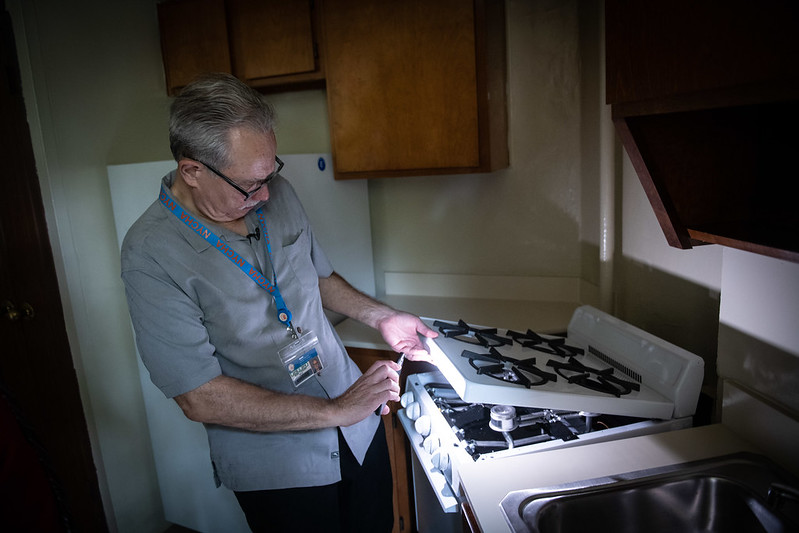
NYCHA CEO Greg Russ inspects a stove at Queensbridge Houses (Michael Appleton/Mayor’s Office)
NYCHA has a gas problem.
Any public housing resident currently impacted by one of more than 50 New York City Housing Authority gas outages would surely agree. In Cypress Hills, they’ve been without gas for close to a year. That bodes poorly for the Astoria Houses, where residents will likely have to cook Thanksgiving meals on a single hot plate.
We've seen across the city, including at a beleaguered co-op here in Astoria, how a natural gas leak can steal one’s ability to cook for weeks — if not months. This only makes sense when you consider the East Harlem and Lower East Side explosions in recent years. Natural gas is as dangerous as it is unhealthy. At NYCHA, however, an abundance of caution often transforms into extreme apathy.
Public housing residents deserve a healthier environment, access to better nutrition, and reliable appliances. Clearly natural gas is the common denominator here, which is why addressing it should be the cornerstone of a Green New Deal for Public Housing. Electric stoves, which have improved substantially over recent years, might be a small solution that goes a long way to improving residents’ quality of life.
Because right now the status quo in which NYCHA residents rely on natural gas cannot continue. Here at the Astoria Houses, a concentrated leak was detected at a 48-unit building on September 22 — at which point gas was shut down and continues to be out. NYCHA, in a quietly released report last month on how it can shrink its carbon footprint, admitted many of its natural gas pipes are original to their buildings and will take up to $143 million to replace leak-prone ones over the next three years.
There are real-life ramifications for these outages. Residents have made it resoundingly clear that a NYCHA-issued hot plate is no replacement for four burners. Rampant outages last fall left tenants in as many as 40 properties without their stoves on Thanksgiving. Kimberly Elliot, an Astoria Houses resident impacted by the current outage, recently raised the good point that, if this keeps happening, why not switch to electric?
As someone who’s dedicated their career to fighting asthma, I couldn’t agree more with that assessment. For more than a decade, doctors have cautioned parents of asthmatic children to ditch the gas stove. That’s because those little blue flames emit so many toxins like carbon monoxide and nitrogen dioxide that boiling a pot of pasta does a number on your respiratory system. Consider what that does to NYCHA residents, given asthma rates are traditionally higher in public housing. That’s at least certainly true in western Queens, where rates are driven up by public housing’s proximity to some of the state’s dirtiest fossil fuel power plants.
Electric stoves have technologically improved in recent years to the point where they’re a viable alternative to natural gas ones. Induction cooktops use magnets to heat food arguably as quick as gas and don’t stay hot as long once you’re done cooking. Public health and climate experts agree that these are a big cure for our dependence on natural gas — more of which is now burned in the U.S. than coal. NYCHA admitted in its report last month that electric stoves have the potential to shrink carbon emissions from its 325-development portfolio.
Of course, there is a valid concern that suddenly putting electric stoves in a bulk of NYCHA’s more than 170,000 units will only burden an already exhausted power grid. This is why a Green New Deal for NYCHA must also leverage the authority’s rooftops for solar power generation. New York City has already successfully put panels atop everything from schools to the Brooklyn Army Terminal. As we invest in NYCHA’s dangerously crumbling, mold-prone rooftops, there should be a City, State, and Federal partnerships to use them to generate renewable energy.
A new federal partnership is incredibly necessary here, both in terms of investment and legislation. Rep. Carolyn Maloney, who I’ve had the pleasure to represent the Astoria Houses with over the last seven years, has a fantastic bill before Congress right now that addresses this. If passed, it would guarantee solar generated on a NYCHA rooftop can power the building below. This is a common-sense measure that ensures a public benefit for residents, spurring our ability to electrify NYCHA.
As Thanksgiving quickly approaches, many residents who already struggle to get by face an uncertain meal plan. Let’s end this inhumane practice by freeing ourselves from the many dangers of natural gas.
***
Costa Constantinides represents Astoria in the New York City Council, where he chairs the Committee on Environmental Protection. On Twitter @Costa4NY.
***
Have an op-ed idea or submission for Gotham Gazette? Email This email address is being protected from spambots. You need JavaScript enabled to view it.
New York City Needs a Public Option for Employment
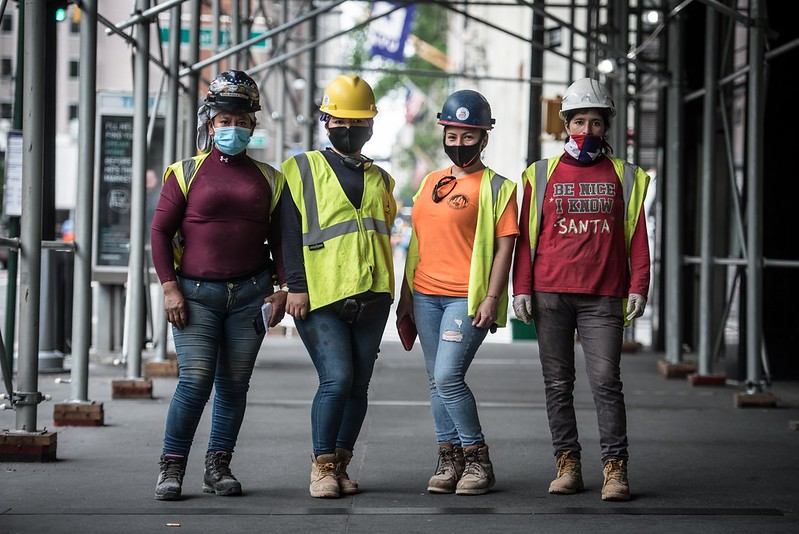
Construction workers in New York City (photo: Michael Appleton/Mayoral Photography Office)
As our city tries to address the economic fallout of the coronavirus pandemic, we have a responsibility to ensure that no New Yorker falls through the cracks while others are on the road to recovery. Low-income, underserved communities have borne the brunt of the pandemic’s health and economic damage. For an inclusive recovery, city leadership must think both inclusively and creatively, and use the vast tools of city government in developing solutions especially focused on our most vulnerable neighbors.
To address high unemployment, New York City should implement a Public Option for Employment, capturing a population of New Yorkers who have historically been shut out from the private sector or stuck in low-wage jobs and placing them on a pathway towards a good job and long-term economic security.
A Public Option for Employment means, simply, that New York City will have a job for everyone who is ready, able, and willing to work when the private sector is not fulfilling our city’s economic needs. This was the underlying concept behind FDR’s New Deal, which was the lynchpin of lifting our nation out of the Great Depression almost a century ago. We have extensive work to do to improve our city, and we have people desperately in need of work. It only makes sense to connect people ready to work with jobs that need doing.
In the Bronx, particularly in neighborhoods of the 15th City Council District like West Farms and East Tremont, many of our residents work in low-wage occupations, and unemployment is as high as 30% in parts of these communities. New York City is on track to lose 500,000 to 600,000 jobs this year, with severe declines in front-facing industries — hotels and food services, administrative services, arts and entertainment, transportation, and retail. The Bronx has been hit the hardest due to the high concentration of workers employed in these job sectors. The coronavirus has disrupted careers and opportunities and forced many Bronxites out of work and into poverty. While losses are widespread, a recovery divide continues to grow between high-income neighborhoods and those that have suffered from generational poverty and disinvestment.
As we look to recover from covid’s devastation, a Public Option for Employment is a unique opportunity to rebuild our economy differently. We must create pathways for unemployed workers, particularly those stigmatized by race, gender identity, or former incarceration status. We must seize upon this moment to make sizable and overdue investments in our infrastructure. Investing in our people will grow the number of construction and engineering workers to fulfill our infrastructure needs, strengthen our storm resiliency, expand mass transit, fix public housing, and improve public utilities and broadband.
As we look at the vulnerabilities exposed by the pandemic, we can develop programs for health services, childcare, and eldercare. And we must look toward the future and consider our resilience through careers in sanitation, parks and recreation, and other projects designed to move toward a green, emission-free city. We have to ensure that we not only foster but also protect human capital. We must have an inspiring vision of what our city workforce can look like if we tap into the many talents that New Yorkers possess by helping them build skills for a new career path.
A Public Option for Employment is a bold strategy to reverse our shrinking workforce, address labor discrimination, combat low wages and reduced work hours, and bring more money into our communities to sustain our local businesses. We must invest in people to restore our collective humanity and elevate everyday New Yorkers out of poverty. A Public Option for Employment can begin as a part-time, work-based, learning apprenticeship program and lead into full-time positions. The apprenticeship portion should come with a guarantee of at least 25 hours a week and should pay no less than $18 an hour.
We know many industries need rapid growth, and much of that is reliant on New Yorkers who do the heavy lifting. For our industries to blossom, our economy to stabilize, and our communities to prosper, our focus has to be on job creation and job training. Any public employment option must include training programs, apprenticeship opportunities, and professional development. Labor unions must be brought to the table, and we must ensure that we provide all the best elements that unionized labor promotes, such as health care coverage, family leave options, and a secure pension. Unemployment offices and workforce development centers should become recruitment centers for a Public Option for Employment program.
You’re probably wondering how we can afford to make such an investment in our workforce in a time when federal dollars seem scarce and austerity looms over our city and state budgets. A program like a Public Option for Employment does not have to launch in one fell swoop. We can phase in implementation, starting by targeting neighborhoods with the highest unemployment rates, and improving our economy, public health, and city infrastructure.
The city’s budget office should immediately begin identifying $1 billion in savings across city agencies to fund the initial rollout of the program. We can look at cancelling the allocation of $11 billion to build four new borough-based jails and reinvest those savings. More importantly, we can and should push our state representatives to create new revenue by taxing the ultra-rich.
With a little political will we can implement big bold ideas that will change peoples lives in New York City. The psychological and social benefits that come with a job can have a transformative effect on the overall health of our city’s residents, both physical and mental, and even reduce poverty-related crime.
***
Elisa Crespo is a candidate for City Council in the 15th City Council District in the Bronx. On Twitter @elisacresponyc.
***
Have an op-ed idea or submission for Gotham Gazette? Email This email address is being protected from spambots. You need JavaScript enabled to view it.
Queens Deserves Better Than a Development Plan That Benefits Too Few
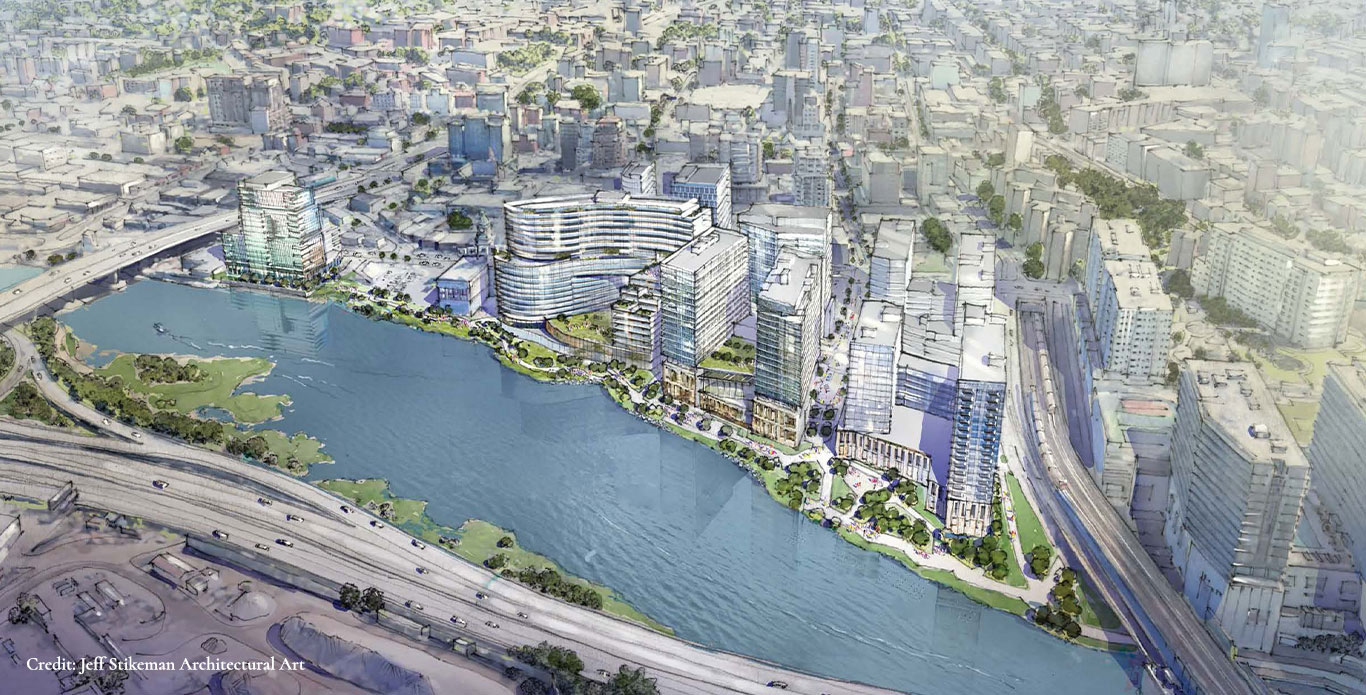
Flushing Waterfront development rendering
When faced with a crisis, whether 9-11 or Hurricane Sandy, New York has always rebuilt. The COVID-19 pandemic and resulting economic damage means that, now more than ever, we need to invest in our city.
But that doesn’t mean that all development is created equal, or that all proposed projects should get a blank check under the guise of recovery. That is why we have a review process for developments seeking to benefit from city approvals – to weigh whose interests should be represented in deciding how to move forward.
The developers behind the plan for a new Special Flushing Waterfront District project, which is now before the City Council, have long claimed that their proposal to build up to 1,700 luxury housing units, over a million square feet of commercial space, and as many as 2,000 luxury hotel rooms will be good for Queens. Now they claim that their project will help Flushing bounce back from the economic consequences of the coronavirus.
Nothing could be further from the truth. Our unions represent the building service and hospitality workers who would be most affected long-term by this project, and we know that as-is, it is not good for frontline workers, for Flushing residents, or for New York City. That is why we oppose the rezoning the developers seek, and why we hope that the City Council will deny the current project.
The pandemic and its economic effects have hit building service and hospitality hard. Thousands of essential workers in building services – cleaners, superintendents and security officers who are 32BJ SEIU members – have risked their health daily to protect the rest of us. And thousands of them have lost their jobs, with some still out of work. Over 80% of Hotel Trades Council (HTC) members are currently unemployed, relying on unemployment insurance, union benefits, and any cash reserves they have to get by. A significant percentage of those unemployed hotel workers live in Queens, and many of them are Flushing residents.
Clearly New York needs more jobs. But real recovery and prosperity require creating jobs with prevailing wages and benefits, like our members have. Contrary to the developers’ assurances, the current version of the Special Flushing Waterfront District plan does not include any credible commitments to make the building service and hospitality jobs their project promises into good jobs that will sustain workers and families. Allowing a mega-project like this to advance without a meaningful guarantee that the working-class people who operate it every day will earn livable wages and be able to afford healthcare would be irresponsible, and a major disservice to New Yorkers.
This project also offers few meaningful benefits for Flushing residents who are struggling to afford housing. Of the residential units planned, as few as 75—roughly 4%—would be set aside for low-income people to rent. This is a drop in the bucket in a neighborhood where 76% of residents are renters, and where two-thirds of those renters are “rent burdened” – paying a too-large percentage of their income for rent.
Throughout the review process, the developers of the Special Flushing Waterfront District have said they will build a similarly sized development as-of-right if the rezoning fails. We reject the notion that this is a choice between bad options, and we encourage decision-makers to do the same. The developers have spent $1.7 million lobbying city government to approve the rezoning, so we know that it is valuable to them. The City Council should stand up for workers and Flushing residents and say no to the rezoning unless those residents will truly share in its gains.
Hit harder than most communities in the country by the COVID-19 pandemic, the last thing that Flushing needs are front-line jobs without standards that protect essential workers, or housing beyond the reach of the majority of people in the neighborhood. We are not against development. But bad development masquerading as recovery will only hurt us worse. Queens deserves better than the current Flushing rezoning plan, and so does our city.
***
Kyle Bragg is the President of 32BJ SEIU and Rich Maroko is the President of New York Hotel & Motels Trades Council. On Twitter @kyle32bj, @32BJSEIU and @NYHTC.
***
Have an op-ed idea or submission for Gotham Gazette? Email This email address is being protected from spambots. You need JavaScript enabled to view it.
Supreme Court Hearings Could Be the Beginning of the End of Your Healthcare
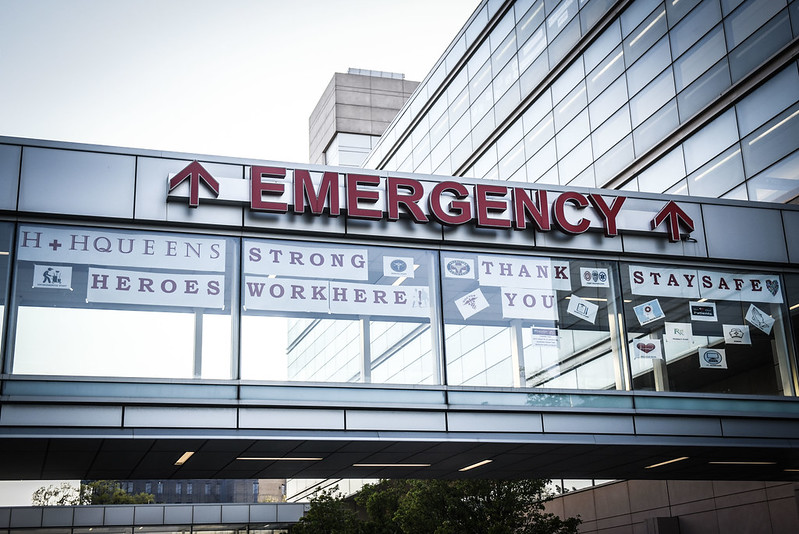
Hospital emergency room (photo: Michael Appleton/Mayor's Office)
It has been a tumultuous week for all of us. The uncertainty about who will lead the country for the next four years has left America anxious, scared, and exhausted.
But with that question appearing settled, other threats remain. Starting Tuesday, the Supreme Court will hear oral arguments in a case that will decide the fate of the Affordable Care Act.
The consequences could not be more dire. As a health-care professional, I see firsthand how important access to quality, affordable health-care is to Americans—especially our country’s most vulnerable.
The timing could also not be worse. Medicaid budgets are shrinking across the country as a pandemic ravages our communities and finances.
Should the ACA be repealed, millions of Americans will lose their healthcare overnight. Premiums will skyrocket. Protections for pre-existing conditions will disappear. The tens of millions who have benefited from the Affordable Care Act will suddenly find themselves scrambling for healthcare—and likely a more expensive version than what they currently have.
It did not have to be this way. The ACA allowed states to expand Medicaid, allowing more Americans access to the core health-care program that’s benefited our country for decades. It allowed young adults to stay on their parents’ health-care plans until the age of 26. It ensured that the one-third of Americans with pre-existing conditions – like diabetes and cancer – are not discriminated against when it comes to health insurance.
I know from both work and personal experience the importance of these aspects of the ACA. As someone who has lost a loved one who battled cystic fibrosis and passed away from pancreatic cancer, I know first-hand how important these protections are, and have dedicated myself to working in healthcare to ensure that I can save as many lives as possible.
Yet for four years, President Trump, his administration, and the Republican Party have done everything in their power to dismantle the ACA and see that millions of Americans either lose their healthcare altogether or pay a higher premium for the care they deserve. The failed attempt to repeal the ACA altogether was a blow to the GOP, but thanks to their changes to the individual mandate, they now have another chance at destroying a landmark health-care law that has proven for more than a decade how valuable it is to the American people.
There have been over 100,000 new COVID-19 cases every day over the past several days. More than 1,000 Americans are dying every single day. The fact that Americans have to even worry about their access to healthcare is not only disconcerting; it’s un-American. As a health-care worker I know first-hand that we take care of one another, and I have been risking my life to save the lives of others for months now.
Despite the efforts of my colleagues and me, we are nowhere near off the hook when it comes to protecting American lives amid this devastating pandemic. We need funding for our hospitals, funding for Medicaid, funding for PPE, and broader assistance from those leading the country. It’s not just my life that depends on it, or the patients I care for in hospital beds; it’s the lives of every New Yorker and every American that are at risk.
The stakes could not be higher. The Supreme Court will rule one way or another in the coming weeks; regardless, we must find solace in unity, and that means we cannot lose hope but must be spurred to action. Under the leadership of President Biden and Vice President Harris, we can not only preserve -- or reinstate if needed -- quality, affordable health-care our fellow citizens deserve, but strengthen the laws and insure even more Americans.
Every voice matters in this fight while we wait for a ruling from the highest court in the land. Call your local representatives, call your Congressional representative, call your U.S. senators. And most of all, call your family to tell them to make calls to remind our lawmakers that healthcare should be a human right, not a privilege.
Together, we can fight this virus, and keep America healthy into the future.
***
Mary Maggio Fischer has worked at Flushing Hospital for 39 years and is a local political activist. She is a member of 1199 SEIU.
***
Have an op-ed idea or submission for Gotham Gazette? Email This email address is being protected from spambots. You need JavaScript enabled to view it.
Building Community and Local Civic Engagement in the Shadow of Presidential Politics
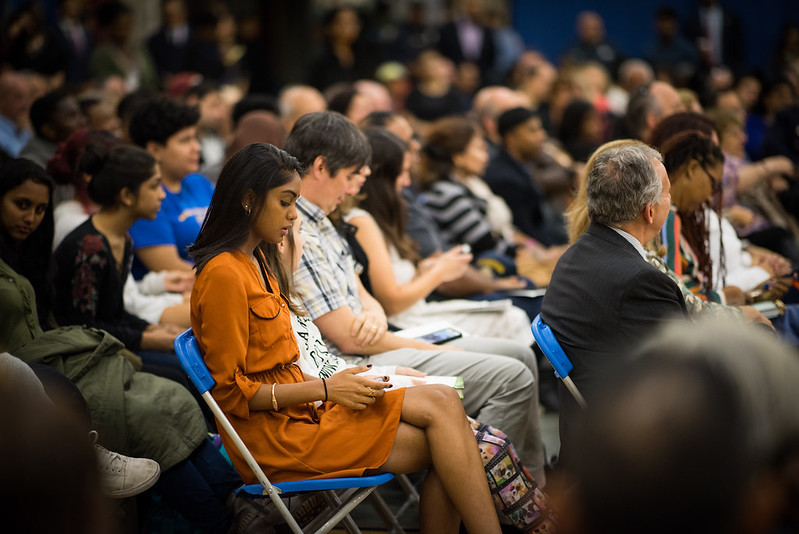
Engaged New Yorkers (photo: Edwin J. Torres/Mayoral Photography Office)
We are in a critical moment. We’ve been seeing how the national political arena has impacted everyday life at a hyper-local level. But amid an ongoing dialogue on polling, voter engagement, and how the presidential election will shape our nation we continue to miss the mark on how elections affect municipalities. The broad strokes of national politics continue to exclude the significant local impact that an election of this magnitude can have.
As we look beyond this month and this election, in the wake of a pandemic that has yet to subside, we are just less than eight months out from a wave of local elections that can flip our democracy on its head. Too few seem concerned about expanding how we engage and inform voters -- but we must.
From one presidential election to the next, and three years of local and state elections, our democracy remains largely stagnant. We continue to invent ways to bring people to the table but fail to actualize these new systems with processes. We pushed student voter registration and now automatic registration, yet the civics curriculum in schools remains nonexistent. We voted for a citywide participatory budgeting process. Yet, it -- one of the only voting processes that encourages student and undocumented civic engagement and enables voting on actual initiatives that directly impact communities -- is not being implemented. Our judges remain invisible to the electorate, while many on the bench gain access to power through backroom deals brokered to control our courts and uphold the law, often to the detriment of our children and underserved neighbors. The Board of Elections continues misfiring every single election, every single year, yet its control by political parties goes unchanged. Poll sites misinformed, ballots unclear, voter purges, and New Yorkers too often left in the dark.
These are reasons local elections are essential. They determine where our tax dollars go, the policing of Black and brown neighbors, housing our seniors, maintaining our transit system, paving our roads -- they dictate the type of struggle we live.
We need leaders who understand how to engage communities of color that have lost faith in a system that falsely alludes to inclusivity and a democratic process. Through in-depth, intentional civic engagement that represents every person's best version in our communities, we can ensure people can be seen, heard, and understood more effectively. That is how more community members will become involved on the local level -- through community board meetings, PTAs, local organizing, and the electoral process. Involvement is how we change our communities' dynamics.
Local engagement in the electoral process can change the face of politics in 2021. After the 2017 election, we found other ways to improve the connection communities have to leadership and the democratic process. We have uncovered ways to uplift the community's voice and give our neighbors a seat at the table. We began building a bench of new leaders in the Bronx, which turned out to be massively beneficial. In the shadow of Trump's presidency, we have been dealt a terrible blow through the coronavirus pandemic. The Bronx was already suffering through unemployment, homelessness, and food insecurity before COVID-19; all have become exacerbated. We already lacked federal support, and many felt as though the Bronx was fated to fall further and further behind. Through the bench of new community leaders that we fostered, we can assemble and find ways to protect Bronxites and look after those most vulnerable. Over the past six months, I and several others stepped up by building a mutual aid network serving hundreds of neighbors weekly, filling the void of social services, providing healthy fresh food and groceries, baby essentials, PPE, and more.
We saw that communities could come together, serve each other, and work towards standard solutions. This model has been replicated across the city and validates the connection that our neighbors deserve. When community members are engaged they share and develop new ideas and invest in finding solutions and discourse to address their communities' issues. This participation influences elected officials and public policy, serves as a check on our government and unites people under a shared purpose; building trust, empathy, deep connections, and a community base.
As we just saw millions vote in the presidential election, we should be reminding them that there are more ways to create an impact. The engagement we feel now, the importance of our vote and this election, needs to be a familiar feeling. We have seen an energy and passion for bringing dignity into our politics. That means we should be fostering a vocal and involved electorate that also considers the local matters that impact us day-to-day. I can only hope that we continue, and am optimistic about the type of representation that would deliver for us if we maintain this engagement locally. Our vote is not only necessary every four years. Our impact can resonate much closer to home. We have to stay engaged and help bring others with us. Our democracy relies not only on our votes but on our voice; let's use it to keep ourselves and others involved, informed, and accountable.
***
Amanda Farias is a candidate for City Council in the 18th City Council District in the Bronx. On Twitter @AmandaFariasNYC.
***
Have an op-ed idea or submission for Gotham Gazette? Email This email address is being protected from spambots. You need JavaScript enabled to view it.
More Youth-Police Partnership is Not NYPD Reform, It’s Dangerous
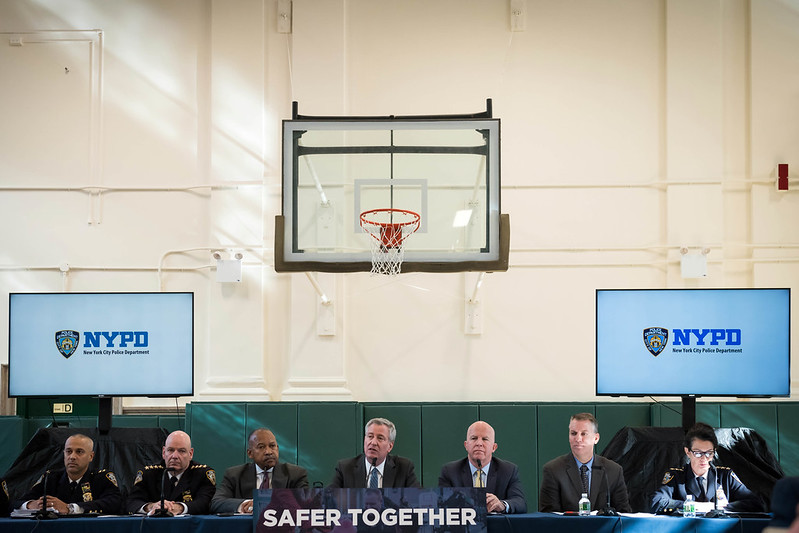
The mayor and top NYPD officials at a community center (photo: Ed Reed/Mayor's Office)
Over the last several weeks, the New York City Police Department convened and broadcasted eight “police reform and reinvention listening sessions” in response to Governor Cuomo’s June Executive Order 203 requiring local police agencies to develop a plan that “reinvents and modernizes police strategies.” These sessions were a sham.
Arriving on the heels of the Defund NYPD movement, the City is choosing what, when, and how to listen. The call to “Defund the NYPD,” for example, grew in the wake of an economic crisis as a way for community members to defend city agencies that exist to provide essential services to the people of New York, including wraparound health services, youth services, public education, and support for people experiencing homelessness. Facing mass public pressure of this sort, the NYPD in turn weaponized the budget justice messaging to paint the police as uniquely victimized. The false talking point that the NYPD was defunded by $1 billion was promulgated by Mayor de Blasio himself and circulated quickly, despite the facts, even those published by the Independent Budget Office, showing a modest $400 million reduction. Meanwhile, the New York City Department of Education’s budget we fought to protect was ultimately defunded by $700 million. Now, this week, the multimillion-dollar police academy welcomes 900 new officers as educators report remote class sizes above 50 students and we brace for a teacher shortage.
By nature of being led by the NYPD, the series of NYPD “listening sessions,” hastily announced and quickly concluded, focused on centering police needs rather than community needs – as demonstrated to us through platitudes made by department chiefs like, “Our ultimate goal is to police New York City the way New York City wants to be policed.” The sessions functioned to amplify police propaganda with little resistance, and to discredit the Defund the NYPD movement.
We believe this process is for the police, not for the people. To be for the people would mean ultimately divesting, demilitarizing, and shrinking the hold police have over young people and their communities. We remain committed to our demand of divesting resources from youth policing, and reallocating resources to the kind of work that helps redefine safety: healthcare, housing, education, youth jobs and noncoercive services.
After observing each of these sessions, we recognize these spaces as a mechanism to further grow the reach of policing into the lives of young people. By design, these meetings solicited support for more police-youth partnerships while ignoring the harmful role of policing in the lives of youth of color. With each meeting came more unchecked, cherry-picked testimony designed to grow the NYPD’s budget specifically to run youth programs – existing projects uplifted and praised included football leagues, days spent hiking, mentorship programs, and the like. Meanwhile, the fate of the Public Schools Athletic League (PSAL) and a barebones Department of Youth and Community Development (DYCD) budget are not afforded the same attention or platform. New York City cannot continue to outsource youth programs to the NYPD while the agencies established for this very purpose – and that do not carry the threat of police violence – are abandoned in the name of austerity.
There is a long history of inciting fear of Black and Latino children as a reason to expand police budgets. Commissioner Shea’s focus on “youth policing” harkens back to the racist, sinister, “super-predator” narrative of the 1980s and ‘90s. We see that legacy continue in the way that the Commissioner has made it his mission to encroach into the lives of New York City’s youth of color, including taking DNA of children without consent, launching a youth policing strategy that includes targeting young people who have been victims of harm, and entering their personal information into NYPD databases as through the gang database.
We condemn this “reinvention” process and this narrative that seeks to use fear to justify an increase in youth-police contact. Ultimately, this process avoids responding to the true demands of this current political moment, which include calls for meaningful investment in the community's ability to support young people, particularly in a time when the public is crying out about the Black lives that have been stolen, interrupted, and criminalized through policing. But we know that youth-police partnerships have historically (and presently) been used as part of a public relations arm of a violent institution. It is not a new phenomenon for the NYPD or any police agency to leverage young people in an attempt to counterbalance public outcry and negative press attention in the wake of widespread police delegitimization.
This process has been built around the goal of “reinventing” policing. Our goal has been and is to remove police from schools as a way to chip away at the institution of youth policing. The $451 million that New York City allocates for school policing each year is money not going toward school nurses, teachers, or counselors. As it stands, the Department of Education doesn’t adequately fund staffed school nurses so school cops take temperatures at the school doors. Educators, restorative justice practitioners, culturally competent mental health counselors, and student coordinators and peacekeepers have the tools to support young people and keep young people safe. Police, the vehicle for the criminalization of young people, are not to be “reinvented.”
***
Ashley C. Sawyer is Senior Director of Campaigns and Charlotte Pope is Director of Policy at Girls for Gender Equity. On Twitter @GGENYC.
***
Have an op-ed idea or submission for Gotham Gazette? Email This email address is being protected from spambots. You need JavaScript enabled to view it.




